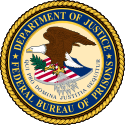Federal Bureau of Prisons facts for kids

Seal of the Federal Bureau of Prisons
|
|
| Agency overview | |
|---|---|
| Formed | 1930 |
| Headquarters | Federal Home Loan Bank Board Building Washington, D.C., U.S. |
| Motto | Correctional Excellence. Respect. Integrity. |
| Employees | 36,697 |
| Annual budget | 7.3 billion USD (FY 2016) |
| Agency executives |
|
| Parent agency | Department of Justice |
The Federal Bureau of Prisons (BOP) is a United States government agency. It is part of the Department of Justice. The BOP is in charge of looking after people who are in federal prisons across the country. Its main goals are to keep prisons safe and secure, and to help people prepare for life after prison.
Contents
What is the Federal Bureau of Prisons?
The Federal Bureau of Prisons was created in 1930. Before that, federal prisons were managed by different parts of the government. The BOP was formed to bring all federal prisons under one system. This helped to make sure that all prisons followed the same rules and standards.
Why was the BOP created?
The BOP was created to make the federal prison system better organized. It also aimed to improve the way people in prison were treated. The goal was to have a fair and consistent system across all federal prisons. This helps to keep everyone safe, including staff and people in prison.
Who leads the BOP?
The BOP is led by a Director. This person is in charge of all the prisons and staff. The Director works with the Department of Justice to make sure the BOP follows all laws. The main office of the BOP is in Washington, D.C..
What does the BOP do?
The main job of the BOP is to keep people in federal prisons safe and secure. This means making sure prisons are orderly and that people follow the rules. The BOP also provides different programs to help people in prison. These programs can include education, job training, and health care.
Keeping prisons safe and secure
Safety is a top priority for the BOP. They work to prevent violence and keep illegal items out of prisons. This helps to protect both the people in prison and the staff who work there. Security measures are in place to make sure no one escapes.
Helping people in federal prisons
The BOP offers many programs to help people in prison. These programs are designed to help them learn new skills. They can also help people prepare to return to their communities. Some examples include:
- Classes to earn a high school diploma (GED)
- Job training in different trades, like plumbing or carpentry
- Programs to help with health issues
- Activities that promote good behavior
Where are federal prisons located?
The Federal Bureau of Prisons manages many different types of facilities. These facilities are located all across the United States. They range from minimum-security camps to high-security penitentiaries. Each type of prison is designed for different needs.
Types of BOP facilities
The BOP has different kinds of prisons. Some are for people who are not considered a high risk. Others are for people who need very strict security.
- Federal Prison Camps (FPCs): These are minimum-security prisons. They have dorm-style housing and less supervision.
- Federal Correctional Institutions (FCIs): These are medium-security prisons. They have more security than FPCs.
- United States Penitentiaries (USPs): These are high-security prisons. They have very strong security measures.
- Federal Medical Centers (FMCs): These facilities provide medical care for people in prison who need it.
Who works for the Federal Bureau of Prisons?
The BOP employs many people in different roles. These staff members work hard to keep prisons running smoothly and safely. They include correctional officers, teachers, doctors, and many other professionals.
Important jobs at the BOP
- Correctional Officers: These officers are responsible for the daily supervision of people in prison. They make sure rules are followed and keep order.
- Teachers: Educators help people in prison learn new skills and earn diplomas.
- Medical Staff: Doctors, nurses, and other health workers provide medical care.
- Counselors: These staff members help people with personal issues and guide them through programs.
Images for kids
See also
 In Spanish: Agencia Federal de Prisiones para niños
In Spanish: Agencia Federal de Prisiones para niños





